Reactive Air Brazing of TiAl Alloy Using Ag-CuO: Microstructure and Joint Properties
Abstract
:1. Introduction
2. Materials and Methods
3. Results and Discussion
3.1. Wettability of Ag-CuO Fillers on TiAl
3.2. Typical Microstructure of TiAl Joint
3.3. Effect of Brazing Temperature of TiAl Joints
4. Conclusions
- Ag-CuO fillers possessed sound wettability on TiAl alloy. The addition of CuO phase can effectively improve the wettability of the filler metal. Ag-2mol%CuO showed the best wetting result on TiAl.
- The typical microstructure of the TiAl brazed joint included the brazing seam zone in the middle of the joint mainly composed of Ag and oxidation layers between the brazing seam and TiAl, mainly composed of TiO2 and Al2O3. The distribution of the oxides was uneven, dividing the oxidation layer into the outer TiO2-rich layer and inner Al2O3-rich layer.
- The optimal brazing parameter was 1020 °C/20 min, at which the joint with good appearance, no obvious defects, and maximum shear strength of 30.8 MPa was obtained.
Author Contributions
Funding
Institutional Review Board Statement
Informed Consent Statement
Data Availability Statement
Acknowledgments
Conflicts of Interest
References
- Appel, F.; Clemens, H.; Fischer, F.D. Modeling concepts for intermetallic titanium aluminides. Prog. Mater. Sci. 2016, 81, 55–124. [Google Scholar] [CrossRef]
- Kim, S.-W.; Hong, J.K.; Na, Y.-S.; Yeom, J.-T.; Kim, S.E. Development of TiAl alloys with excellent mechanical properties and oxidation resistance. Mater. Des. 2014, 54, 814–819. [Google Scholar] [CrossRef]
- Wu, X. Review of alloy and process development of TiAl alloys. Intermetallics 2006, 14, 1114–1122. [Google Scholar] [CrossRef]
- Clemens, H.; Mayer, S. Intermetallic titanium aluminides in aerospace applications–processing, microstructure and properties. Mater. High Temp. 2016, 33, 560–570. [Google Scholar] [CrossRef]
- Ding, J.; Zhang, M.; Liang, Y.; Ren, Y.; Dong, C.; Lin, J. Enhanced high-temperature tensile property by gradient twin structure of duplex high-Nb-containing TiAl alloy. Acta Mater. 2018, 161, 1–11. [Google Scholar] [CrossRef]
- Mallory, L.; Baeslack, W.; Phillips, D. Evolution of the weld heat-affected zone microstructure in a Ti-48AI-2Cr-2Nb gamma titanium aluminide. J. Mater. Sci. Lett. 1994, 13, 1061–1065. [Google Scholar] [CrossRef]
- Guoqing, C.; Binggang, Z.; Wei, L.; Jicai, F. Crack formation and control upon the electron beam welding of TiAl-based alloys. Intermetallics 2011, 19, 1857–1863. [Google Scholar] [CrossRef]
- Liu, J.; Dahmen, M.; Ventzke, V.; Kashaev, N.; Poprawe, R. The effect of heat treatment on crack control and grain refinement in laser beam welded β-solidifying TiAl-based alloy. Intermetallics 2013, 40, 65–70. [Google Scholar] [CrossRef]
- Cai, X.; Sun, D.; Li, H.; Meng, C.; Wang, L.; Shen, C. Dissimilar joining of TiAl alloy and Ni-based superalloy by laser welding technology using V/Cu composite interlayer. Opt. Laser Technol. 2019, 111, 205–213. [Google Scholar] [CrossRef]
- Çam, G.; İpekoğlu, G.; Bohm, K.-H.; Koçak, M. Investigation into the microstructure and mechanical properties of diffusion bonded TiAl alloys. J. Mater. Sci. 2006, 41, 5273–5282. [Google Scholar] [CrossRef]
- Du, Z.; Zhang, K.; Lu, Z.; Jiang, S. Microstructure and mechanical properties of vacuum diffusion bonding joints for γ-TiAl based alloy. Vacuum 2018, 150, 96–104. [Google Scholar] [CrossRef]
- Simões, S.; Viana, F.; Koçak, M.; Ramos, A.S.; Vieira, M.T.; Vieira, M.F. Diffusion bonding of TiAl using reactive Ni/Al nanolayers and Ti and Ni foils. Mater. Chem. Phys. 2011, 128, 202–207. [Google Scholar] [CrossRef]
- Xiaoguo, S.; Jian, C.; Jiakun, L.; Liyan, Z.; Jicai, F. Reaction-diffusion bonding of high Nb containing TiAl alloy. Rare Met. Mater. Eng. 2014, 43, 28–31. [Google Scholar] [CrossRef]
- Feng, J.; Dai, X.; Wang, D.; Li, R.; Cao, J. Microstructure evolution and mechanical properties of ZrO2/TiAl joints vacuum brazed by Ag–Cu filler metal. Mater. Sci. Eng. A 2015, 639, 739–746. [Google Scholar] [CrossRef]
- Shiue, R.K.; Wu, S.K.; Chen, S.Y. Infrared brazing of TiAl intermetallic using BAg-8 braze alloy. Acta Mater. 2003, 51, 1991–2004. [Google Scholar] [CrossRef]
- Shiue, R.K.; Wu, S.K.; Chen, S.Y. Infrared brazing of TiAl intermetallic using pure silver. Intermetallics 2004, 12, 929–936. [Google Scholar] [CrossRef]
- Song, X.; Zhao, Y.; Hu, S.; Cao, J.; Fu, W.; Feng, J. Wetting of AgCu-Ti filler on porous Si3N4 ceramic and brazing of the ceramic to TiAl alloy. Ceram. Int. 2018, 44, 4622–4629. [Google Scholar] [CrossRef]
- Simoes, S.; Soares, A.; Tavares, C.J.; Guedes, A. Joining of TiAl Alloy Using Novel Ag-Cu Sputtered Coated Ti Brazing Filler. Microsc. Microanal. 2019, 25, 192–195. [Google Scholar] [CrossRef] [PubMed]
- Lee, S.; Wu, S.; Lin, R. Infrared joining of TiAl intermetallics using Ti-15Cu-15Ni foil—I. The microstructure morphologies of joint interfaces. Acta Mater. 1998, 46, 1283–1295. [Google Scholar] [CrossRef]
- Lee, S.; Wu, S.; Lin, R. Infrared joining of TiAl intermetallics using Ti-15Cu-15Ni foil—II. The microstructural evolution at high temperature. Acta Mater. 1998, 46, 1297–1305. [Google Scholar] [CrossRef]
- Qiu, Q.; Wang, Y.; Yang, Z.; Hu, X.; Wang, D. Microstructure and mechanical properties of TiAl alloy joints vacuum brazed with Ti–Zr–Ni–Cu brazing powder without and with Mo additive. Mater. Des. 2016, 90, 650–659. [Google Scholar] [CrossRef]
- Cao, J.; Si, X.; Li, W.; Song, X.; Feng, J. Reactive air brazing of YSZ-electrolyte and Al2O3-substrate for gas sensor sealing: Interfacial microstructure and mechanical properties. Int. J. Hydrog. Energy 2017, 42, 10683–10694. [Google Scholar] [CrossRef]
- Lee, D.; Woo, J.; Park, S. Oxidation behavior of Ag-Cu-Ti brazing alloys. Mater. Sci. Eng. A 1999, 268, 202–207. [Google Scholar] [CrossRef]
- Wang, Q.; Zhang, S.; Lin, T.; Zhang, P.; He, P.; Paik, K.-W. Highly mechanical and high-temperature properties of Cu–Cu joints using citrate-coated nanosized Ag paste in air. Prog. Nat. Sci. Mater. Int. 2021, 31, 129–140. [Google Scholar] [CrossRef]
- Zhang, S.; Wang, Q.; Lin, T.; Zhang, P.; He, P.; Paik, K.-W. Cu-Cu joining using citrate coated ultra-small nano-silver pastes. J. Manuf. Process. 2021, 62, 546–554. [Google Scholar] [CrossRef]
- Kim, J.; Hardy, J.S.; Weil, K.S. Silver-copper oxide based reactive air braze for joining yttria-stabilized zirconia. J. Mater. Res. 2005, 20, 636–643. [Google Scholar] [CrossRef]
- Kim, J.Y.; Hardy, J.S.; Scott Weil, K. Effects of CuO content on the wetting behavior and mechanical properties of a Ag–CuO braze for ceramic joining. J. Am. Ceram. Soc. 2005, 88, 2521–2527. [Google Scholar] [CrossRef]
- Raju, K.; Yoon, D.-H. Reactive air brazing of GDC–LSCF ceramics using Ag–10 wt% CuO paste for oxygen transport membrane applications. Ceram. Int. 2016, 42, 16392–16395. [Google Scholar] [CrossRef]
- Si, X.; Cao, J.; Song, X.; Qu, Y.; Feng, J. Reactive air brazing of YSZ ceramic with novel Al2O3 nanoparticles reinforced Ag-CuO-Al2O3 composite filler: Microstructure and joint properties. Mater. Des. 2017, 114, 176–184. [Google Scholar] [CrossRef]
- Si, X.; Cao, J.; Song, X.; Wang, Z.; Wang, Z.; Feng, J. Evolution behavior of Al2O3 nanoparticles reinforcements during reactive air brazing and its role in improving the joint strength. Mater. Des. 2017, 132, 96–104. [Google Scholar] [CrossRef]
- Tillmann, W.; Anar, N.B.; Wojarski, L. Mechanical behavior of reactive air brazed (RAB) Crofer 22 APU-Al2O3 joints at ambient temperature. SN Appl. Sci. 2020, 2, 809. [Google Scholar] [CrossRef] [Green Version]
- Wang, X.Y.; Si, X.Q.; Li, C.; Guo, X.J.; Cao, J. Joining the BaZr0.1Ce0.7Y0.1Yb0.1O3-delta Electrolyte to AISI 441 Interconnect for Protonic Ceramic Fuel Cell Applications: Interfacial Microstructure and Long-Term Stability. ACS Appl. Energ. Mater. 2021, 4, 7346–7354. [Google Scholar] [CrossRef]
- Lang, C.; Schütze, M. TEM investigations of the early stages of TiAl oxidation. Oxid. Met. 1996, 46, 255–285. [Google Scholar] [CrossRef]
- Maurice, V.; Despert, G.; Zanna, S.; Josso, P.; Bacos, M.-P.; Marcus, P. XPS study of the initial stages of oxidation of α2-Ti3Al and γ-TiAl intermetallic alloys. Acta Mater. 2007, 55, 3315–3325. [Google Scholar] [CrossRef]
- Swadźba, R.; Marugi, K. STEM investigations of γ-TiAl produced by additive manufacturing after isothermal oxidation. Corros. Sci. 2020, 169, 108617. [Google Scholar] [CrossRef]
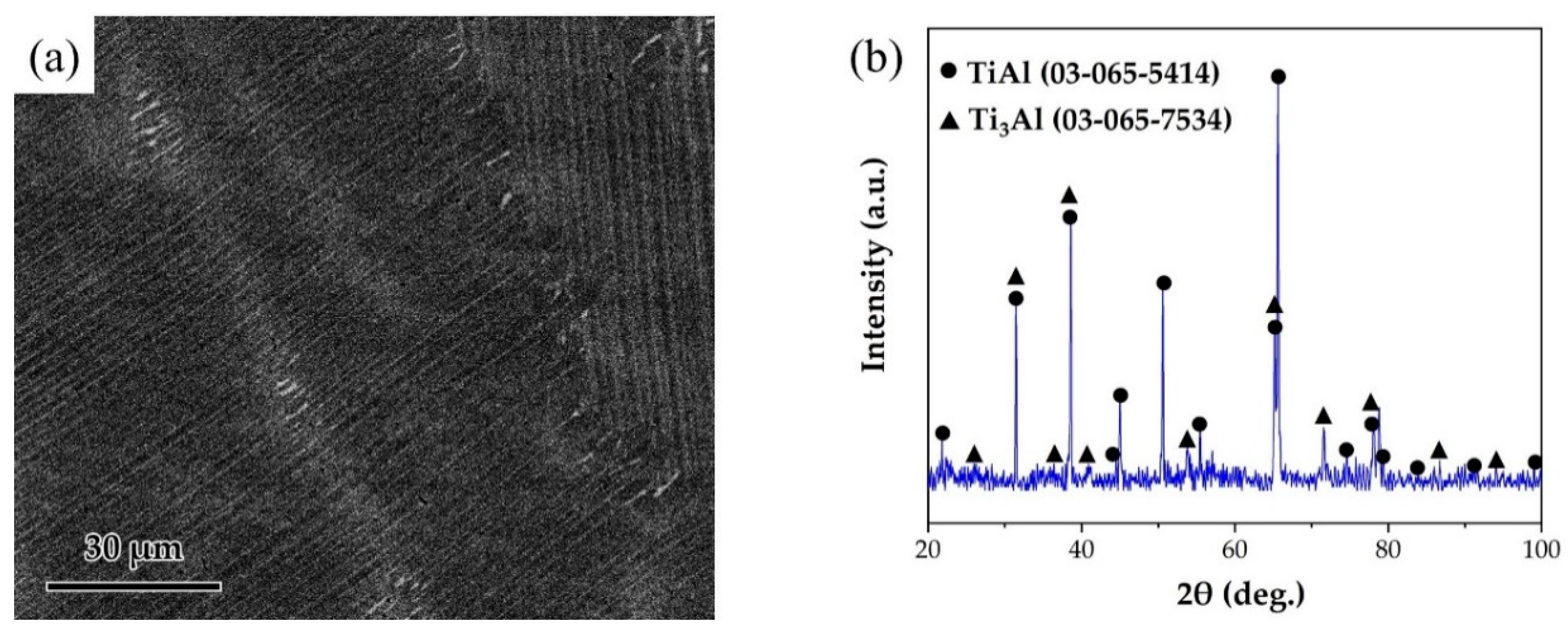



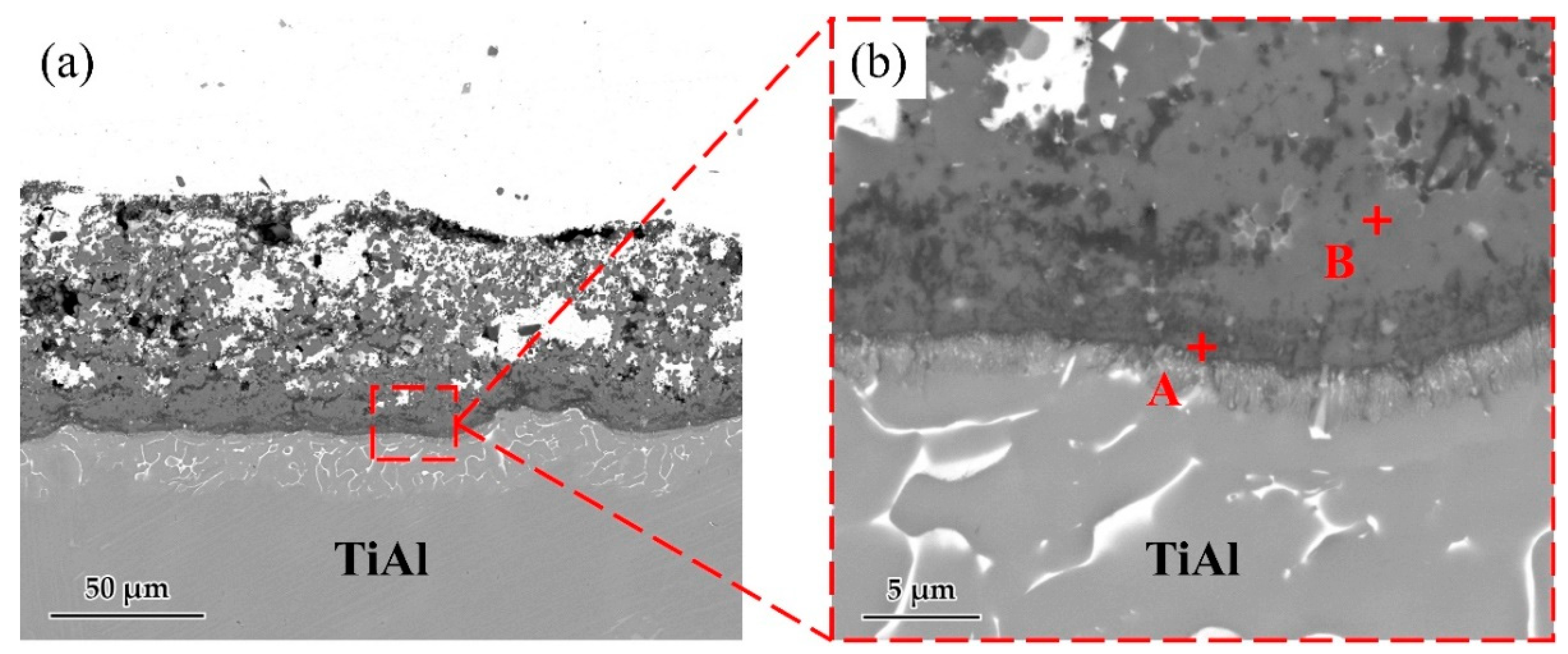
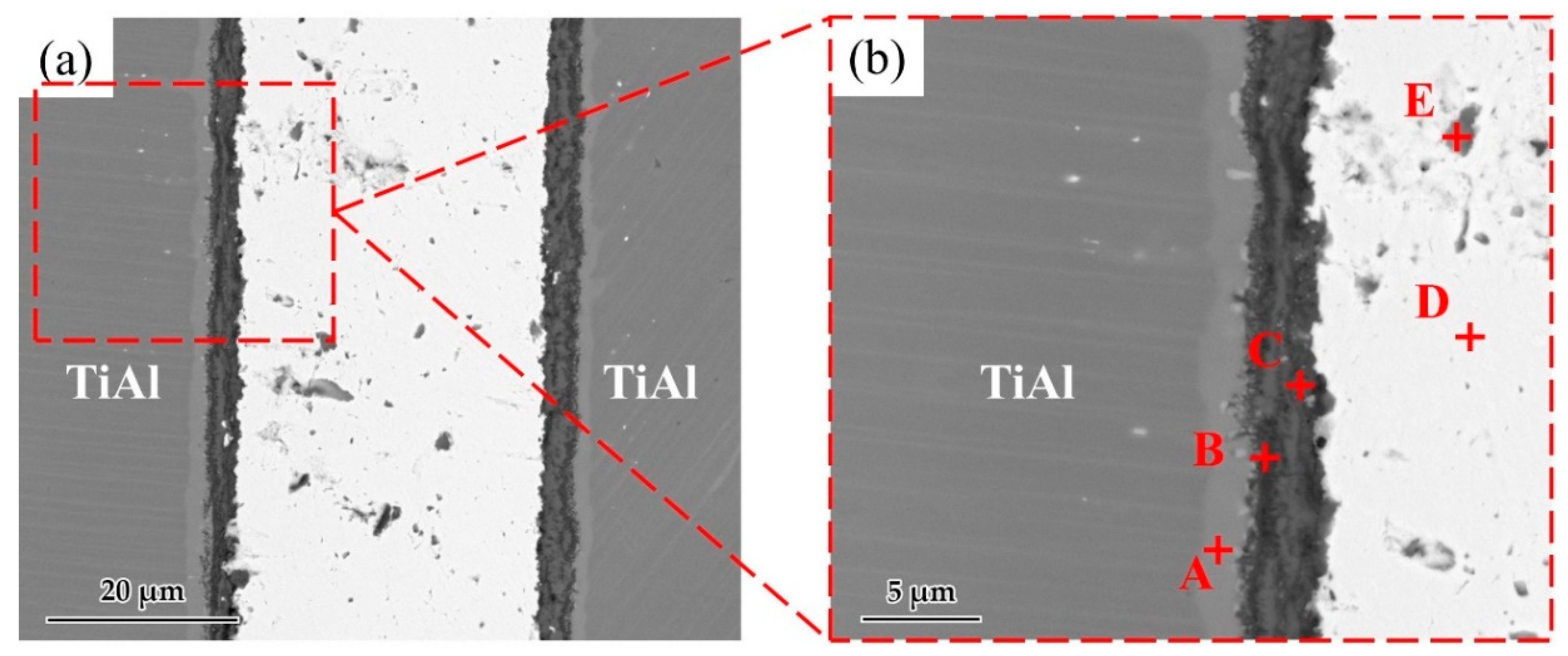
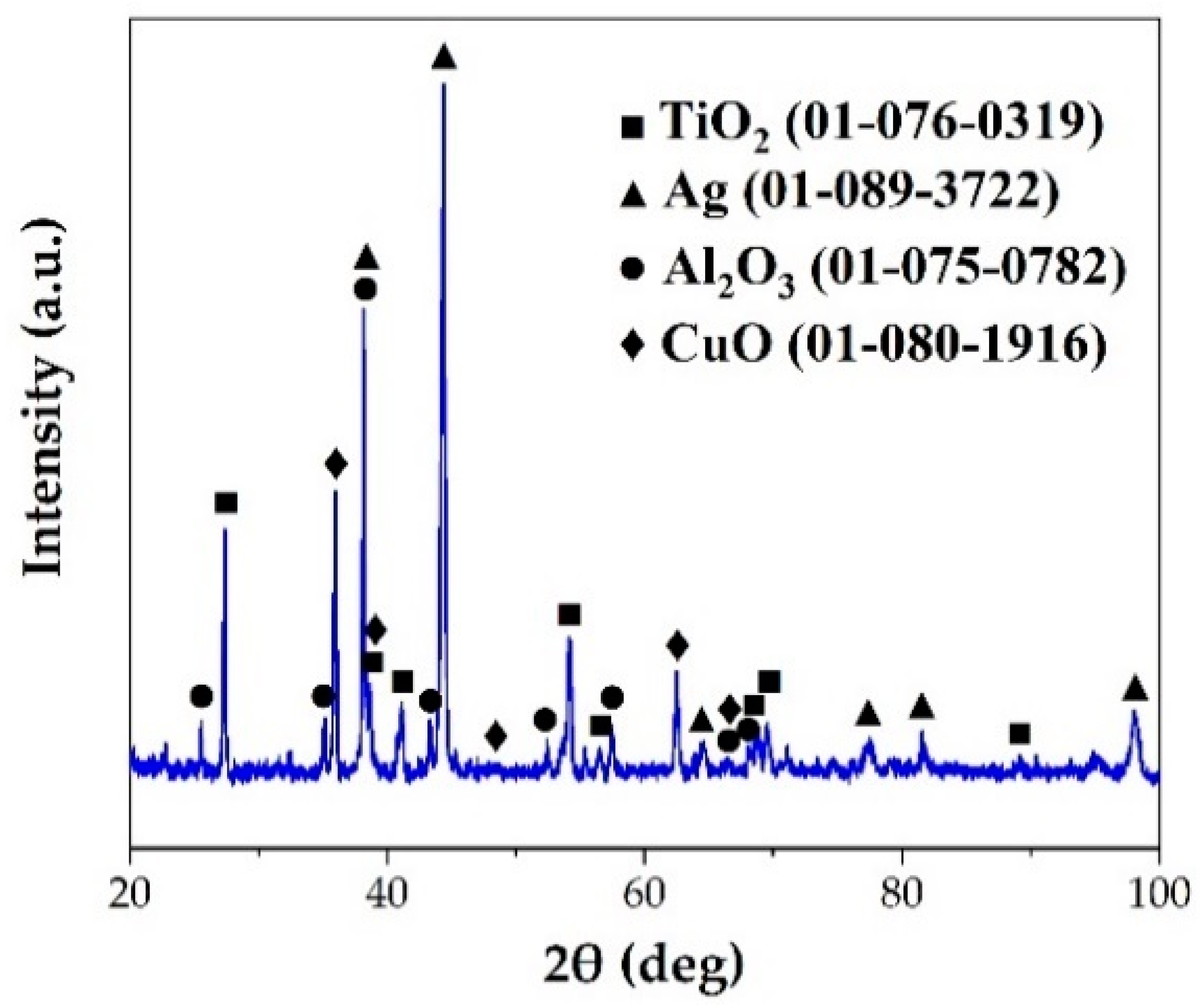

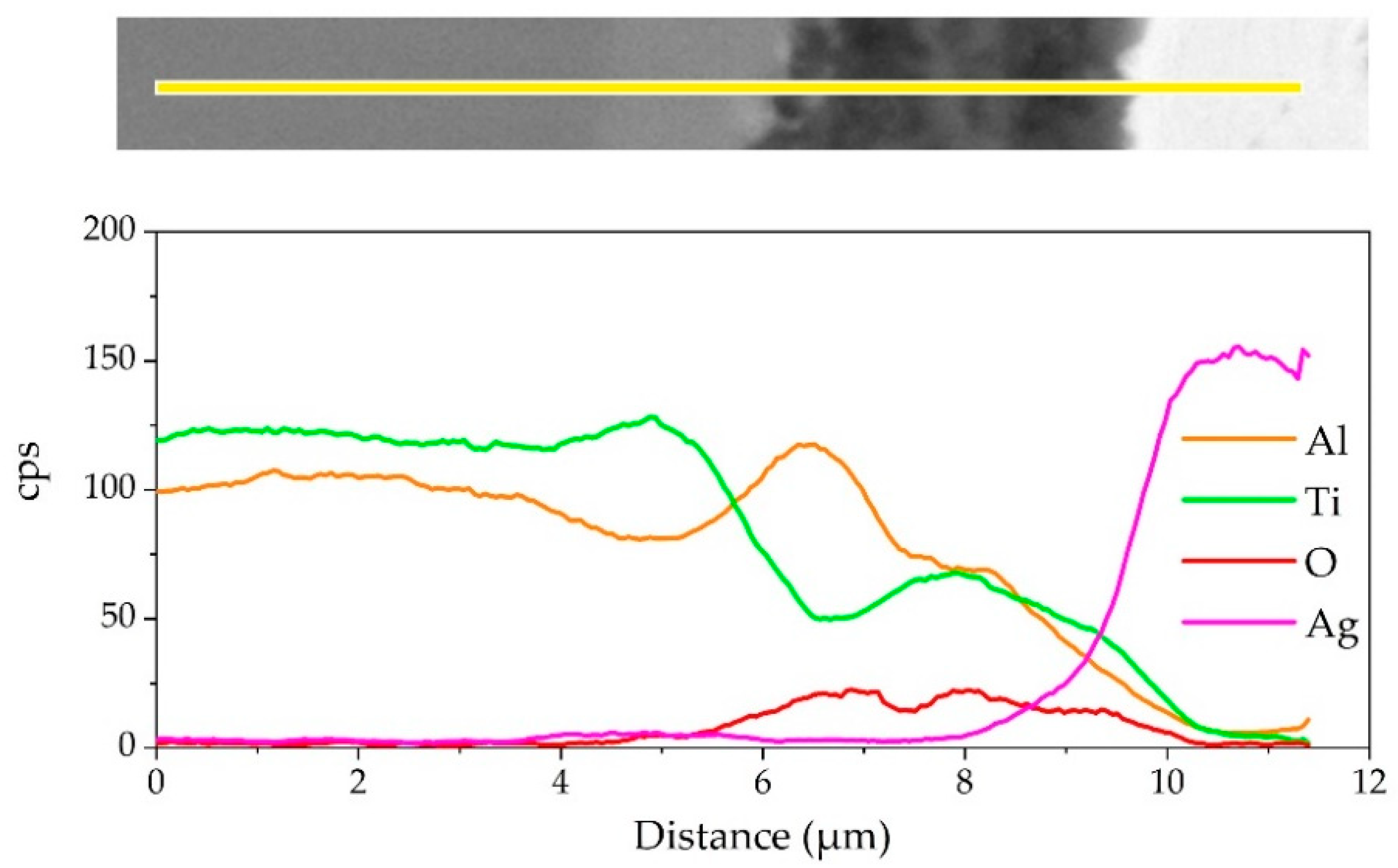
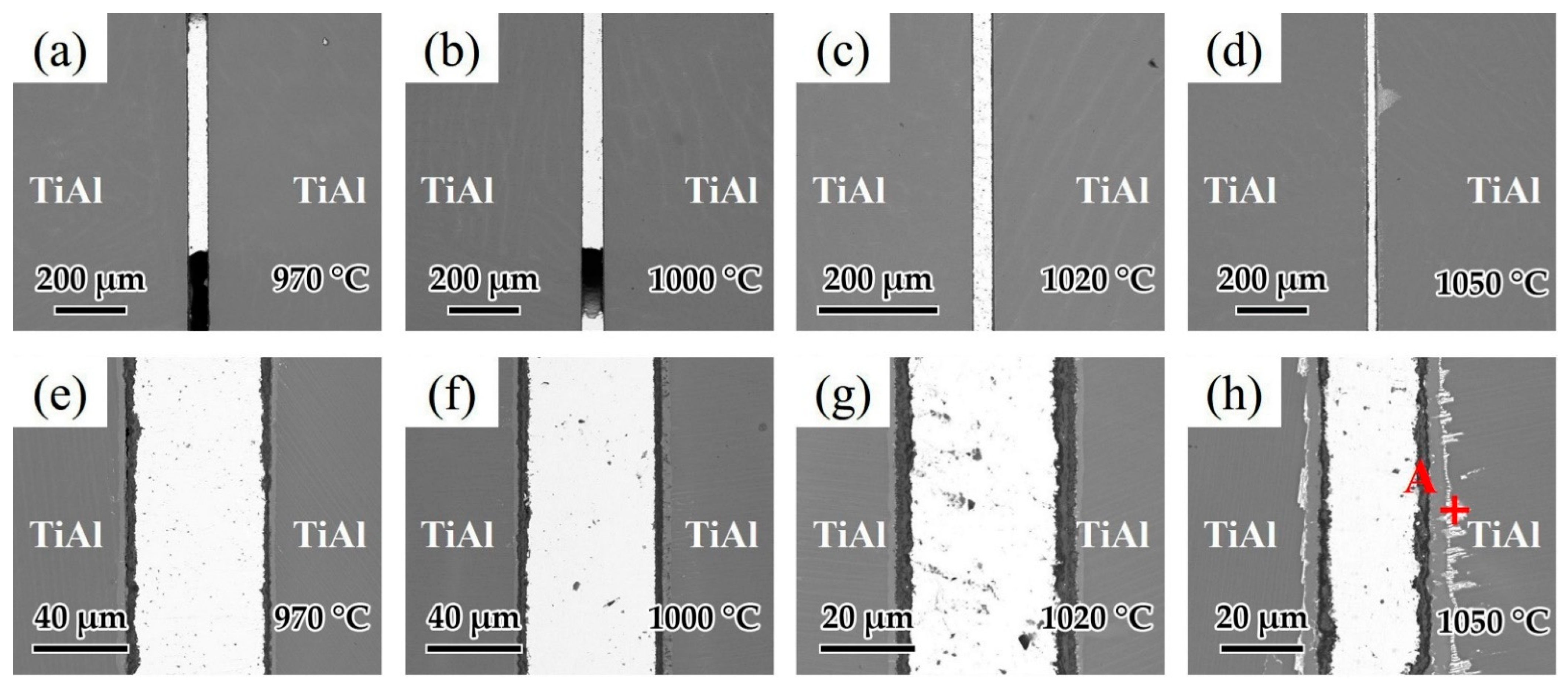

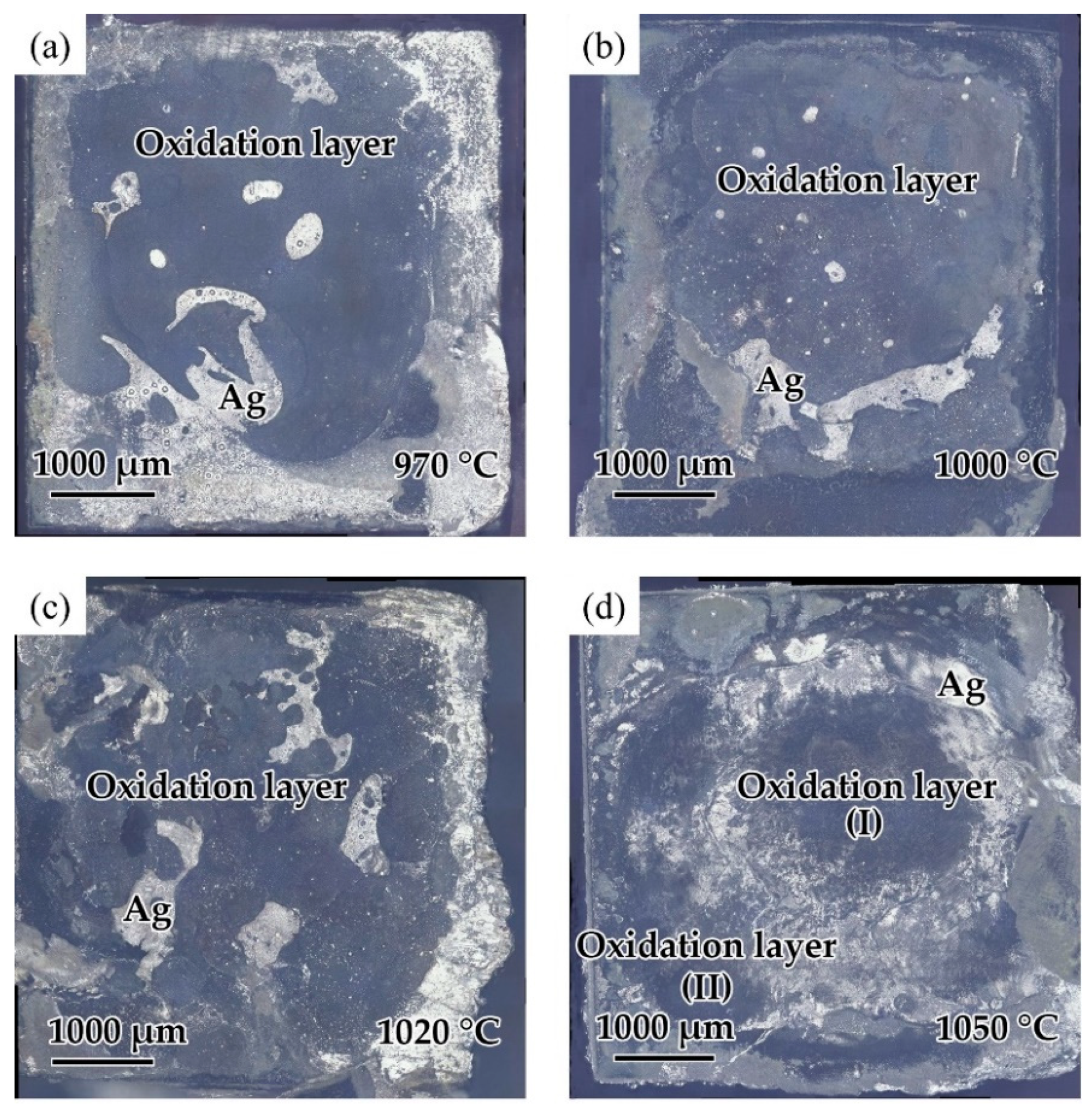
| Ag | 99 | 98 | 96 | 94 | 92 |
| CuO | 1 | 2 | 4 | 6 | 8 |
| Spot | Ti | Al | O | Cu | Ag |
|---|---|---|---|---|---|
| A | 0.7 | 17.8 | 24.3 | 44.1 | 13.1 |
| Spots | Ti | Al | O | Cu | Ag |
|---|---|---|---|---|---|
| A | 12.7 | 18.6 | 68.1 | 0.4 | 0.2 |
| B | 25.0 | 4.7 | 68.9 | 0.8 | 0.6 |
| Spots | Ti | Al | O | Cu | Ag | Possible Phase |
|---|---|---|---|---|---|---|
| A | 51.8 | 38.2 | 9.4 | - | 0.6 | TiAl + Ti3Al |
| B | 28.5 | 33.5 | 37.6 | - | 0.4 | TiO2 + Al2O3 |
| C | 19.2 | 12.8 | 67.7 | 0.1 | 0.2 | TiO2 + Al2O3 |
| D | 0.5 | 0.2 | 12.1 | 2.1 | 85.1 | Ag + CuO |
| E | 8.9 | 8.8 | 30.0 | 1.1 | 51.2 | TiO2 + Al2O3 + CuO |
| Spot | Ti | Al | O | Cu | Ag |
|---|---|---|---|---|---|
| A | 24.3 | 17.0 | 19.2 | 0.3 | 39.2 |
Publisher’s Note: MDPI stays neutral with regard to jurisdictional claims in published maps and institutional affiliations. |
© 2021 by the authors. Licensee MDPI, Basel, Switzerland. This article is an open access article distributed under the terms and conditions of the Creative Commons Attribution (CC BY) license (https://creativecommons.org/licenses/by/4.0/).
Share and Cite
Yang, H.; Si, X.; Li, C.; Cao, J. Reactive Air Brazing of TiAl Alloy Using Ag-CuO: Microstructure and Joint Properties. Crystals 2021, 11, 1496. https://doi.org/10.3390/cryst11121496
Yang H, Si X, Li C, Cao J. Reactive Air Brazing of TiAl Alloy Using Ag-CuO: Microstructure and Joint Properties. Crystals. 2021; 11(12):1496. https://doi.org/10.3390/cryst11121496
Chicago/Turabian StyleYang, Haoran, Xiaoqing Si, Chun Li, and Jian Cao. 2021. "Reactive Air Brazing of TiAl Alloy Using Ag-CuO: Microstructure and Joint Properties" Crystals 11, no. 12: 1496. https://doi.org/10.3390/cryst11121496
APA StyleYang, H., Si, X., Li, C., & Cao, J. (2021). Reactive Air Brazing of TiAl Alloy Using Ag-CuO: Microstructure and Joint Properties. Crystals, 11(12), 1496. https://doi.org/10.3390/cryst11121496








